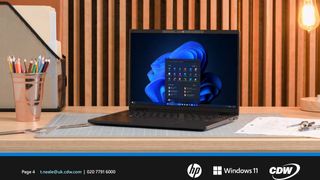Ubuntu vs. Windows 7 on the business desktop
Microsoft Windows may be the de facto standard desktop operating system in business environments, but high costs, restrictive licences and constant security issues are leading an increasing number of companies to consider open source alternatives — as Kat Orphanides explains.

Ubuntu Desktop

Ubuntu Desktop

Ubuntu Desktop

Ubuntu Desktop

Ubuntu Desktop

Ubuntu Desktop

Ubuntu Desktop

Ubuntu Desktop

Ubuntu Desktop

Ubuntu Desktop

Ubuntu Desktop

Ubuntu Desktop

Ubuntu Desktop

Ubuntu Desktop

Ubuntu Desktop

Ubuntu Desktop

Ubuntu Desktop

Ubuntu Desktop
Of these, Canonical's Ubuntu Linux distribution is regarded as one of the most fully developed operating systems and for this head-to-head, we've compared the current Ubuntu 11.10 (Oneiric Ocelot') to Windows 7. In particular, we're interested in its interface and software capabilities from an end-user's perspective, plus the ease of installation, security and maintenance considerations for administrators.
Installation
Canonical Ubuntu can be installed alongside an existing operating system, or can completely replace it, and it offers fine control over the partitioning and allocation of hard drive space. A number of file systems are also available, including Ext4, Ext3, ReiserFS, JFS, XFS, and FAT32. In an ideal world, an operating system should be ready to use as soon as it's installed, but that's seldom the case.It is worth noting that manually configuring an Ubuntu partition to co-exist alongside one or more others may result in the new partition not being immediately available. We had to boot into an existing operating system partition and update the GRUB Bootloader to reflect the new drive configuration, after which Ubuntu was available as a bootable option.
With the partition table set up accordingly, whether manually or automatically by Ubuntu, installation conveniently continues in the background while other system settings are configured, but it's also possible to create a slipstreamed installation disk that requires no user interaction.
Configuration
In an ideal world, an operating system should be ready to use as soon as it's installed, but that's seldom the case. While both Windows 7 and Ubuntu do an excellent job of recognising most common hardware and installing the necessary drivers, it's inevitable that some hardware will need to be set-up by hand.
Graphics cards tend to be the most common device to require manual driver installation. Basic graphics functionality is offered by default in both Windows and Ubuntu, but more sophisticated features, such as 3D or audio over HDMI support, require the appropriate proprietary driver. For Ubuntu, these are available from its Software Centre and they're always worth installing, even if a graphics cards more advanced features aren't required.
Proprietary video driver installation was reasonably easy on our test system with an AMD Radeon HD 6990 graphics card, but we were initially unable to configure the test PC's two monitor set-up using AMD's Catalyst Control Centre.
This was remedied with judicious use of the command line ("sudo aticonfig --initial -f", if anyone is wondering), but these sorts of solutions are considerably more complex that most Windows users will ever have to deal with.
Get the ITPro. daily newsletter
Receive our latest news, industry updates, featured resources and more. Sign up today to receive our FREE report on AI cyber crime & security - newly updated for 2024.
K.G. is a journalist, technical writer, developer and software preservationist. Alongside the accumulated experience of over 20 years spent working with Linux and other free/libre/open source software, their areas of special interest include IT security, anti-malware and antivirus, VPNs, identity and password management, SaaS infrastructure and its alternatives.
You can get in touch with K.G. via email at reviews@kgorphanides.com.




